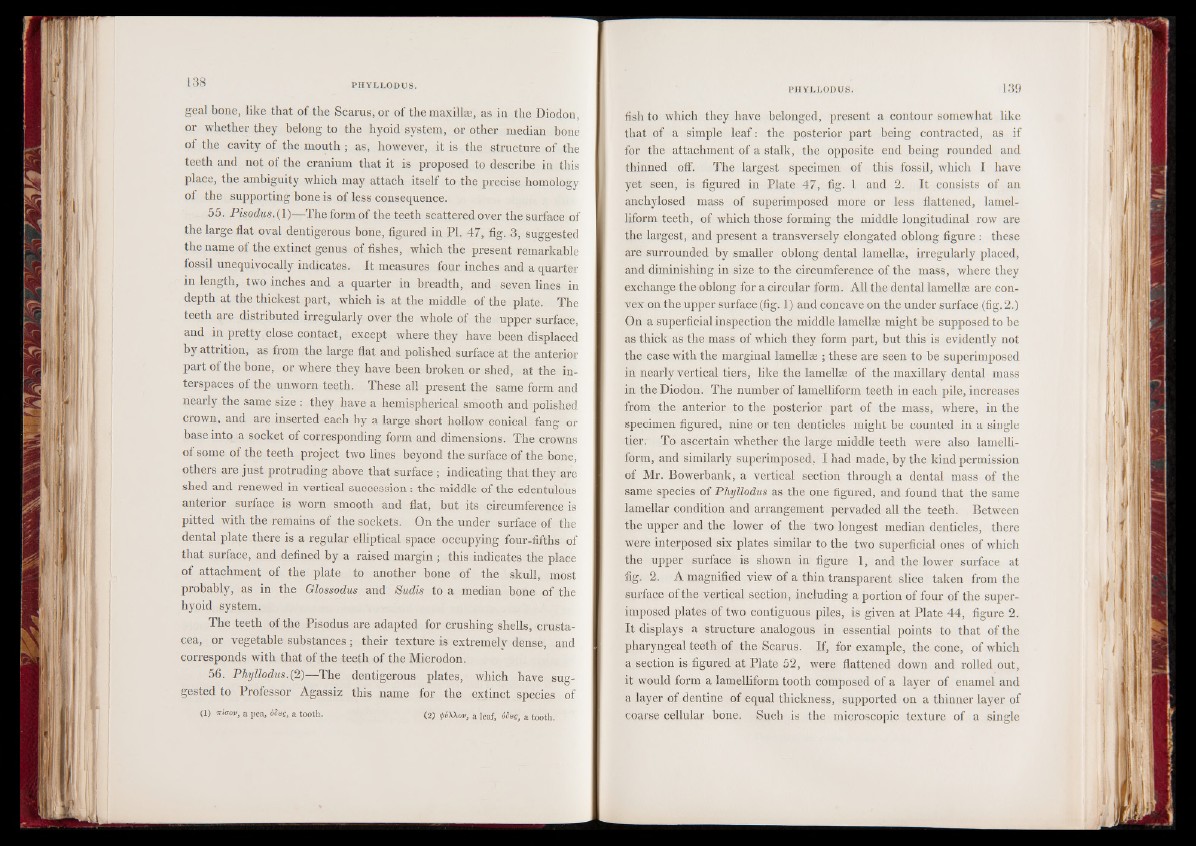
geal bone, like that of the Scarus, or of the maxillae, as in the Diodon,
or whether they belong to the hyoid system, or other median bone
of the cavity of the mouth ; as, however, it is the structure of the
teeth and not of the cranium that it is proposed to describe in this
place, the ambiguity which may attach itself to the precise homology
of the supporting bone is of less consequence.
55. Pisodus.( 1)—The form of the teeth scattered over the surface of
the large flat oval dentigerous bone, figured in PL 47, fig. 3, suggested
the name of the extinct genus of fishes, which the present remarkable
fossil unequivocally indicates. It measures four inches and a quarter
in length, two inches and a quarter in breadth, and seven lines in
depth at the thickest part, which is at the middle of the plate. The
teeth are distributed irregularly over the whole of the upper surface,
and in pretty close contact, except where they have been displaced
by attrition, as from the large flat and polished surface at the anterior
part of the bone, or where they have been broken or shed, at the interspaces
of the unworn teeth. These all present the same form and
nearly the same size : they have a hemispherical smooth and polished
crown, and are inserted each by a large short hollow conical fang or
base into a socket of corresponding form and dimensions. The crowns
of some of the teeth project two lines beyond the surface of the bone,
others are just protruding above that surface ; indicating that they are
shed and renewed in vertical succession : the middle of the edentulous
anterior surface is worn smooth and flat, but its circumference is
pitted with the remains of the sockets. On the under surface of the
dental plate there is a regular elliptical space occupying four-fifths of
that surface, and defined by a raised margin; this indicates the place
of attachment of the plate to another bone of the skull, most
probably, as in the Glossodus and Sudis to a median bone of the
hyoid system.
The teeth of the Pisodus are adapted for crushing shells, Crustacea,
or vegetable substances ; their texture is extremely dense, and
corresponds with that of the teeth of the Microdon.
56. Phyllodus.(2)—The dentigerous plates, which have suggested
to Professor Agassiz this name for the extinct species of
(1) Khov, a pea, ««£, a tooth. (2) fiMov, a leaf, Wes, a tooth.
fish to which they have belonged, present a contour somewhat like
that of a simple leaf: the posterior part being contracted, as if
for the attachment of a stalk, the opposite end being rounded and
thinned off. The largest specimen of this fossil, which I have
yet seen, is figured in Plate 47, fig. I and 2. It consists of an
anchylosed mass of superimposed more or less flattened, lamel-
liform teeth, of which those forming the middle longitudinal row are
the largest, and present a transversely elongated oblong figure > these
are surrounded by smaller oblong dental lamellae, irregularly placed,
and diminishing in size to the circumference of the mass, where they
exchange the oblong for a circular form. All the dental lamellae are convex
on the upper surface (fig. 1) and concave on the under surface (fig. 2.)
On a superficial inspection the middle lamellae might be supposed to be
as thick as the mass of which they form part, but this is evidently not
the case with the marginal lamellae ; these are seen to be superimposed
in nearly vertical tiers, like the lamellae of the maxillary dental mass
in the Diodon. The number of lamelliform teeth in each pile, increases
from the anterior to the posterior part of the mass, where, in the
specimen figured, nine or ten denticles might be counted in a single
tier. To ascertain whether the large middle teeth were also lamelliform,
and similarly superimposed, I had made, by the kind permission
of Mr. Bowerbank, a vertical section through a dental mass of the
same species of Phyllodus as the one figured, and found that the same
lamellar condition and arrangement pervaded all the teeth. Between
the upper and the lower of the two longest median denticles, there
were interposed six plates similar to the two superficial ones of which
the upper surface is shown in figure 1, and the lower surface at
fig. 2. A magnified view of a thin transparent slice taken from the
surface of the vertical section, including a portion of four of the superimposed
plates of two contiguous piles, is given at Plate 44, figure 2.
It displays a structure analogous in essential points to that of the
pharyngeal teeth of the Scarus. If, for example, the cone, of which
a section is figured at Plate 52, were flattened down and rolled out,
it would form a lamelliform tooth composed of a layer of enamel and
a layer of dentine of equal thickness, supported on a thinner layer of
coarse cellular bone. Such is the microscopic texture of a single